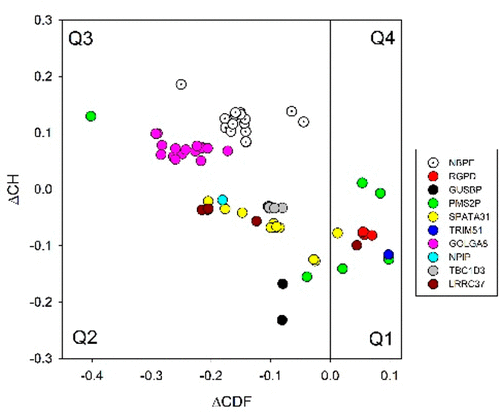当前位置:
X-MOL 学术
›
J. Phys. Chem. B
›
论文详情
Our official English website, www.x-mol.net, welcomes your
feedback! (Note: you will need to create a separate account there.)
Intrinsic Disorder in Human Proteins Encoded by Core Duplicon Gene Families.
The Journal of Physical Chemistry B ( IF 2.8 ) Pub Date : 2020-09-03 , DOI: 10.1021/acs.jpcb.0c07676 Nathan W Van Bibber 1 , Cornelia Haerle 1 , Roy Khalife 1 , Guy W Dayhoff 2 , Vladimir N Uversky 1, 3, 4
The Journal of Physical Chemistry B ( IF 2.8 ) Pub Date : 2020-09-03 , DOI: 10.1021/acs.jpcb.0c07676 Nathan W Van Bibber 1 , Cornelia Haerle 1 , Roy Khalife 1 , Guy W Dayhoff 2 , Vladimir N Uversky 1, 3, 4
Affiliation

|
Segmental duplications (i.e., highly homologous DNA fragments greater than 1 kb in length that are present within a genome at more than one site) are typically found in genome regions that are prone to rearrangements. A noticeable fraction of the human genome (∼5%) includes segmental duplications (or duplicons) that are assumed to play a number of vital roles in human evolution, human-specific adaptation, and genomic instability. Despite their importance for crucial events such as synaptogenesis, neuronal migration, and neocortical expansion, these segmental duplications continue to be rather poorly characterized. Of particular interest are the core duplicon gene (CDG) families, which are replicates sharing common “core” DNA among the randomly attached pieces and which expand along single chromosomes and might harbor newly acquired protein domains. Another important feature of proteins encoded by CDG families is their multifunctionality. Although it seems that these proteins might possess many characteristic features of intrinsically disordered proteins, to the best of our knowledge, a systematic investigation of the intrinsic disorder predisposition of the proteins encoded by core duplicon gene families has not been conducted yet. To fill this gap and to determine the degree to which these proteins might be affected by intrinsic disorder, we analyzed a set of human proteins encoded by the members of 10 core duplicon gene families, such as NBPF, RGPD, GUSBP, PMS2P, SPATA31, TRIM51, GOLGA8, NPIP, TBC1D3, and LRRC37. Our analysis revealed that the vast majority of these proteins are highly disordered, with their disordered regions often being utilized as means for the protein–protein interactions and/or targeted for numerous posttranslational modifications of different nature.
中文翻译:

核心Duplicon基因家族编码的人类蛋白质的内在疾病。
通常在易于重排的基因组区域中发现片段重复(即,长度大于1 kb的高度同源的DNA片段,存在于一个基因组中的一个以上位点)。人类基因组的显着部分(约5%)包括分段重复(或双重复),这些重复被认为在人类进化,人类特异性适应和基因组不稳定性中起着至关重要的作用。尽管它们对于关键事件如突触形成,神经元迁移和新皮层扩张很重要,但这些节段重复的特征仍然很差。特别令人感兴趣的是核心双复制子基因(CDG)家族,它们是在随机附着的片段之间共享共同的“核心” DNA的复制,并且沿着单个染色体扩展,并且可能包含新获得的蛋白质结构域。CDG家族编码的蛋白质的另一个重要特征是它们的多功能性。尽管这些蛋白似乎具有内在失调蛋白的许多特征,但据我们所知,尚未对核心双链体基因家族编码的蛋白的内在失调倾向进行系统研究。为了填补这一空白,并确定这些蛋白质可能受内在疾病影响的程度,我们分析了一组由10个核心duplicon基因家族成员编码的人类蛋白质,例如 尚未对核心双链体基因家族编码的蛋白质的固有疾病易感性进行系统研究。为了填补这一空白,并确定这些蛋白质可能受内在疾病影响的程度,我们分析了一组由10个核心duplicon基因家族成员编码的人类蛋白质,例如 尚未对核心双链体基因家族编码的蛋白质的固有疾病易感性进行系统研究。为了填补这一空白并确定这些蛋白质可能受到内在障碍的影响程度,我们分析了一组由10个核心双链体基因家族成员编码的人类蛋白质,例如NBPF,RGPD,GUSBP,PMS2P,SPATA31,TRIM51,GOLGA8,NPIP,TBC1D3和LRRC37。我们的分析表明,这些蛋白质中的绝大多数是高度无序的,它们的无序区域通常被用作蛋白质与蛋白质相互作用的手段和/或靶向许多不同性质的翻译后修饰。
更新日期:2020-09-18
中文翻译:

核心Duplicon基因家族编码的人类蛋白质的内在疾病。
通常在易于重排的基因组区域中发现片段重复(即,长度大于1 kb的高度同源的DNA片段,存在于一个基因组中的一个以上位点)。人类基因组的显着部分(约5%)包括分段重复(或双重复),这些重复被认为在人类进化,人类特异性适应和基因组不稳定性中起着至关重要的作用。尽管它们对于关键事件如突触形成,神经元迁移和新皮层扩张很重要,但这些节段重复的特征仍然很差。特别令人感兴趣的是核心双复制子基因(CDG)家族,它们是在随机附着的片段之间共享共同的“核心” DNA的复制,并且沿着单个染色体扩展,并且可能包含新获得的蛋白质结构域。CDG家族编码的蛋白质的另一个重要特征是它们的多功能性。尽管这些蛋白似乎具有内在失调蛋白的许多特征,但据我们所知,尚未对核心双链体基因家族编码的蛋白的内在失调倾向进行系统研究。为了填补这一空白,并确定这些蛋白质可能受内在疾病影响的程度,我们分析了一组由10个核心duplicon基因家族成员编码的人类蛋白质,例如 尚未对核心双链体基因家族编码的蛋白质的固有疾病易感性进行系统研究。为了填补这一空白,并确定这些蛋白质可能受内在疾病影响的程度,我们分析了一组由10个核心duplicon基因家族成员编码的人类蛋白质,例如 尚未对核心双链体基因家族编码的蛋白质的固有疾病易感性进行系统研究。为了填补这一空白并确定这些蛋白质可能受到内在障碍的影响程度,我们分析了一组由10个核心双链体基因家族成员编码的人类蛋白质,例如NBPF,RGPD,GUSBP,PMS2P,SPATA31,TRIM51,GOLGA8,NPIP,TBC1D3和LRRC37。我们的分析表明,这些蛋白质中的绝大多数是高度无序的,它们的无序区域通常被用作蛋白质与蛋白质相互作用的手段和/或靶向许多不同性质的翻译后修饰。











































 京公网安备 11010802027423号
京公网安备 11010802027423号